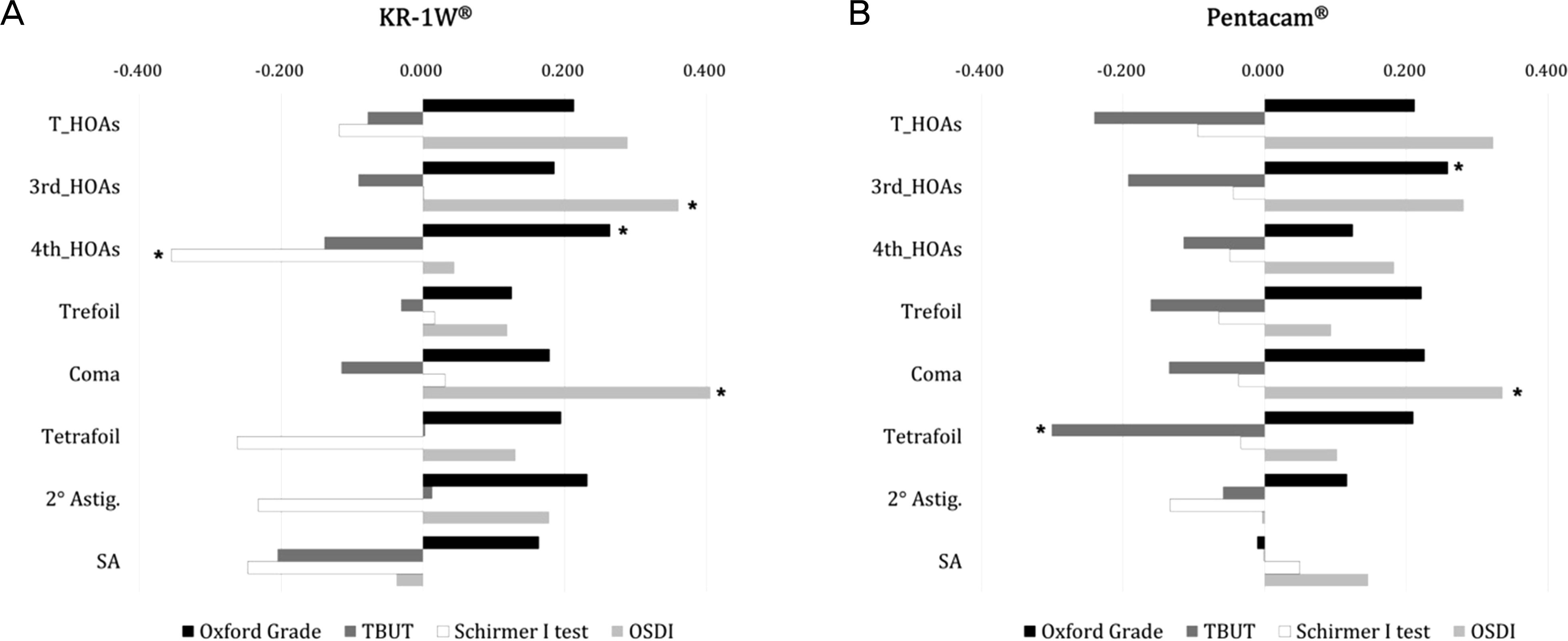Abstract
Purpose
To compare the corneal first surface higher-order aberrations (HOAs) of normal subjects and patients with dry eye using KR-1W® (Topcon Corp., Tokyo, Japan) and Pentacam® HR (Oculus Inc., Dutenhofen, Germany). We analyzed the relationship between the aberrations and the diagnostic parameters of dry eye.
Methods
We evaluated anterior corneal HOAs in 71 normal eyes and 71 dry eyes using KR-1W® and Pentacam®. Dry eye patients were examined for fluorescein staining, tear break-up time (TBUT), and Schirmer I test. Ocular Surface Disease Index (OSDI) was used for assessment of subjective symptoms in dry eye patients.
Results
HOAs measured by both instruments were greater in the dry eye group than in the control group, although HOAs using KR-1W® only achieved statistical significance. The anterior corneal HOAs measured by the 2 instruments were significantly correlated with superficial punctate keratitis. Moreover, TBUT and the Shirmer I test negatively correlated, and OSDI positively correlated, with anterior corneal HOAs.
Go to : 
References
1. Miljanović B, Dana R, Sullivan DA, Schaumberg DA. Impact of dry eye syndrome on vision-related quality of life. Am J Ophthalmol. 2007; 143:409–15.

2. Goto E, Yagi Y, Matsumoto Y, Tsubota K. Impaired functional visual acuity of dry eye patients. Am J Ophthalmol. 2002; 133:181–6.

3. Thibos LN, Hong X. Clinical applications of the Shack-Hartmann aberrometer. Optom Vis Sci. 1999; 76:817–25.

4. Koh S, Maeda N, Hirohara Y. . Serial measurements of high-er-order aberrations after blinking in normal subjects. Invest Ophthalmol Vis Sci. 2006; 47:3318–24.

5. Miranda MA, O'Donnell C, Radhakrishnan H. Repeatability of corneal and ocular aberration measurements and changes in aberrations over one week. Clin Exp Optom. 2009; 92:253–66.

6. Piñero DP, Juan JT, Alió JL. Intrasubject repeatability of internal aberrometry obtained with a new integrated aberrometer. J Refract Surg. 2011; 27:509–17.

7. Denoyer A, Rabut G, Baudouin C. Tear film aberration dynamics and vision-related quality of life in patients with dry eye disease. Ophthalmology. 2012; 119:1811–8.

8. Choi SH, Shin YI. Changes in higher order aberration according to tearfilm instability analyzed by continuous measurement using wavefront. J Korean Ophthalmol Soc. 2012; 53:1076–80.

9. Uchino Y, Uchino M, Dogru M. . Changes in dry eye diagnostic status following implementation of revised Japanese dry eye diagnostic criteria. Jpn J Ophthalmol. 2012; 56:8–13.

10. Bron AJ, Evans VE, Smith JA. Grading of corneal and conjunctival staining in the context of other dry eye tests. Cornea. 2003; 22:640–50.

11. Schiffman RM, Christianson MD, Jacobsen G. . Reliability and validity of the Ocular Surface Disease Index. Arch Ophthalmol. 2000; 118:615–21.

12. Carkeet A, Velaedan S, Tan YK. . Higher order ocular aberrations after cycloplegic and non-cycloplegic pupil dilation. J Refract Surg. 2003; 19:316–22.

13. Campbell CE. A new method for describing the aberrations of the eye using Zernike polynomials. Optom Vis Sci. 2003; 80:79–83.

14. Kim JH, Lim T, Kim MJ, Tchah H. Changes of higher-order aberrations with the use of various mydriatics. Ophthalmic Physiol Opt. 2009; 29:602–5.

15. Methodologies to diagnose and monitor dry eye disease: report of the Diagnostic Methodology Subcommittee of the International Dry Eye WorkShop (2007). Ocul Surf. 2007; 5:108–52.
16. Charman WN. Wavefront aberration of the eye: a review. Optom Vis Sci. 1991; 68:574–83.
17. Williams D, Yoon GY, Porter J. . Visual benefit of correcting higher order aberrations of the eye. J Refract Surg. 2000; 16:S554–9.

18. Kaido M, Matsumoto Y, Shigeno Y. . Corneal fluorescein staining correlates with visual function in dry eye patients. Invest Ophthalmol Vis Sci. 2011; 52:9516–22.

19. Montés-Micó R, Cáliz A, Alió JL. Changes in ocular aberrations after instillation of artificial tears in dryeye patients. J Cataract Refract Surg. 2004; 30:1649–52.

20. Huang B, Mirza MA, Qazi MA, Pepose JS. The effect of punctal occlusion on wavefront aberrations in dry eye patients after laser in situ keratomileusis. Am J Ophthalmol. 2004; 137:52–61.

21. Kopf M, Yi F, Robert ID. . Tear film surface quality with soft contact lenses using dynamic videokeratoscopy. Journal of Optometry. 2008; 1:14–21.

22. Barkana Y, Gerber Y, Elbaz U. . Central corneal thickness measurement with the Pentacam Scheimpflug system, optical low- coherence reflectometry pachymeter, and ultrasound pachymetry. J Cataract Refract Surg. 2005; 31:1729–35.
23. Read SA, Collins MJ, Iskander DR, Davis BA. Corneal topography with Scheimpflug imaging and videokeratography: comparative study of normal eyes. J Cataract Refract Surg. 2009; 35:1072–81.

24. Shankar H, Taranath D, Santhirathelagan CT, Pesudovs K. Repea- tability of corneal first-surface wavefront aberrations measured with Pentacam corneal topography. J Cataract Refract Surg. 2008; 34:727–34.
25. Savini G, Barboni P, Carbonelli M, Hoffer KJ. Repeatability of automatic measurements by a new Scheimpflug camera combined with Placido topography. J Cataract Refract Surg. 2011; 37:1809–16.

Go to : 
 | Figure 1.Comparison of the HOAs of dry eye group to the control group using KR-1W® (A) and Pentacam® (B). HOAs = high-er-order aberrations; 2˚ Astig. = secondary astigmatism; SA = spherical aberration. * p < 0.05 based on independent sample t-test between the dry eyes and control group. |
 | Figure 2.Comparison of HOAs between KR-1W® and Pentacam® in normal (A) and dry eye groups (B). HOAs = higher-order aberrations; 2˚ Astig. = secondary astigmatism; SA = spherical aberration. * p < 0.05 based on independent sample t-test between the dry eyes and control group. |
 | Figure 3.Correlation coefficients between 4 parameters and higher-order aberrations (HOAs) measured by KR-1W® (A) and Pentacam® (B) in the dry eye group. T_HOAs = total HOAs; 3rd_HOAs = third HOAs; 4th_HOAs = fourth HOAs; 2˚ Astig. = secondary astigmatism; SA = spherical aberration; TBUT = tear break-up time; OSDI = ocular surface disease index. * p < 0.05 based on Spearman’s correlation coefficient. |




 PDF
PDF ePub
ePub Citation
Citation Print
Print


 XML Download
XML Download